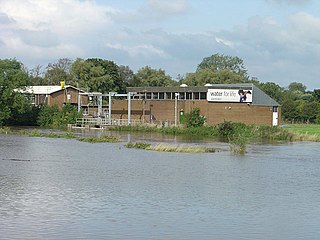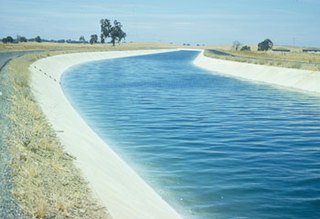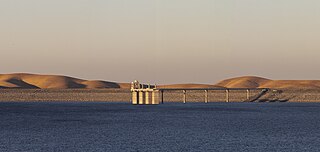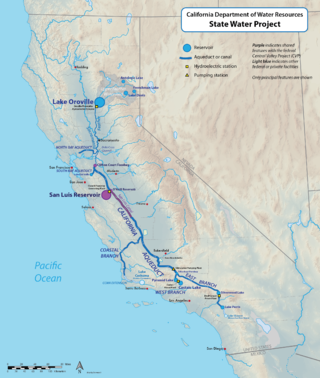Related Research Articles

The Ogallala Aquifer is a shallow water table aquifer surrounded by sand, silt, clay, and gravel located beneath the Great Plains in the United States. As one of the world's largest aquifers, it underlies an area of approximately 174,000 sq mi (450,000 km2) in portions of eight states. It was named in 1898 by geologist N. H. Darton from its type locality near the town of Ogallala, Nebraska. The aquifer is part of the High Plains Aquifer System, and resides in the Ogallala Formation, which is the principal geologic unit underlying 80% of the High Plains.

Water extraction is the process of taking water from any source, either temporarily or permanently, for flood control or to obtain water for, for example, irrigation. The extracted water could also be used as drinking water after suitable treatment.

Groundwater is the water present beneath Earth's surface in rock and soil pore spaces and in the fractures of rock formations. About 30 percent of all readily available freshwater in the world is groundwater. A unit of rock or an unconsolidated deposit is called an aquifer when it can yield a usable quantity of water. The depth at which soil pore spaces or fractures and voids in rock become completely saturated with water is called the water table. Groundwater is recharged from the surface; it may discharge from the surface naturally at springs and seeps, and can form oases or wetlands. Groundwater is also often withdrawn for agricultural, municipal, and industrial use by constructing and operating extraction wells. The study of the distribution and movement of groundwater is hydrogeology, also called groundwater hydrology.

The San Joaquin River is the longest river of Central California. The 366-mile (589 km) long river starts in the high Sierra Nevada, and flows through the rich agricultural region of the northern San Joaquin Valley before reaching Suisun Bay, San Francisco Bay, and the Pacific Ocean. An important source of irrigation water as well as a wildlife corridor, the San Joaquin is among the most heavily dammed and diverted of California's rivers.

The California Water Wars were a series of political conflicts between the city of Los Angeles and farmers and ranchers in the Owens Valley of Eastern California over water rights.

The Governor Edmund G. Brown California Aqueduct is a system of canals, tunnels, and pipelines that conveys water collected from the Sierra Nevada Mountains and valleys of Northern and Central California to Southern California. Named after California Governor Edmund Gerald "Pat" Brown Sr., the over 400-mile (640 km) aqueduct is the principal feature of the California State Water Project.

The Sacramento–San Joaquin River Delta, or California Delta, is an expansive inland river delta and estuary in Northern California. The Delta is formed at the western edge of the Central Valley by the confluence of the Sacramento and San Joaquin rivers and lies just east of where the rivers enter Suisun Bay, which flows into San Francisco Bay, then the Pacific Ocean via San Pablo Bay. The Delta is recognized for protection by the California Bays and Estuaries Policy. Sacramento–San Joaquin Delta was designated a National Heritage Area on March 12, 2019. The city of Stockton is located on the San Joaquin River at the eastern edge of the delta. The total area of the Delta, including both land and water, is about 1,100 square miles (2,800 km2). Its population is around 500,000.

The Delta–Mendota Canal is a 117-mile-long (188 km) aqueduct in central California, United States. The canal was designed and completed in 1951 by the U.S. Bureau of Reclamation as part of the Central Valley Project. It carries freshwater to replace San Joaquin River water which is diverted into the Madera Canal and Friant-Kern Canal at Friant Dam.

San Luis Dam, also known as B.F. Sisk Dam, is a major earth-filled dam in Merced County, California, which forms San Luis Reservoir, the largest off-stream reservoir in the United States. The dam and reservoir are located in the Diablo Range to the east of Pacheco Pass and about 10 miles (16 km) west of Los Banos. San Luis Dam, a jointly-owned state and federal facility, stores more than 2 million acre feet (2.5 km3) of water for the California State Water Project and the federal Central Valley Project. Although the dam is located in the valley of San Luis Creek, the majority of its water comes from man-made aqueducts which are supplied from other rivers in Northern California.

The California State Water Project, commonly known as the SWP, is a state water management project in the U.S. state of California under the supervision of the California Department of Water Resources. The SWP is one of the largest public water and power utilities in the world, providing drinking water for more than 27 million people and generating an average of 6,500 GWh of hydroelectricity annually. However, as it is the largest single consumer of power in the state itself, it has a net usage of 5,100 GWh.

Westlands Water District is a water district in central California, a local-government entity formed in 1952, that holds long-term contracts for water supplied by the Central Valley Project and the California State Water Project.

Overdrafting is the process of extracting groundwater beyond the equilibrium yield of an aquifer. Groundwater is one of the largest sources of fresh water and is found underground. The primary cause of groundwater depletion is the excessive pumping of groundwater up from underground aquifers. Insufficient recharge can lead to depletion, reducing the usefulness of the aquifer for humans. Depletion can also have impacts on the environment around the aquifer, such as soil compression and land subsidence, local climatic change, soil chemistry changes, and other deterioration of the local environment.
Groundwater-related subsidence is the subsidence of land resulting from unsustainable groundwater extraction. It is a growing problem in the developing world as cities increase in population and water use, without adequate pumping regulation and enforcement. One estimate has 80% of serious U.S. land subsidence problems associated with the excessive extraction of groundwater.
The Peripheral Canal was a series of proposals starting in the 1940s to divert water from California's Sacramento River, around the periphery of the San Joaquin-Sacramento River Delta, to uses farther south. The canal would have attempted to resolve a problem with the quality of water pumped south. Pumps create such a powerful suction that the boundary between freshwater to saltwater has shifted inland, negatively affecting the environment. The pumps have increased by 5 to 7 million acre-feet the amount of water exported each year to the Central Valley and Southern California. However, the peripheral canal as proposed would have reduced the overall freshwater flow into the Delta and move the freshwater-saltwater interface further inland, causing damage to Delta agriculture and ecosystems.

The Friant-Kern Canal is a 152 mi (245 km) aqueduct managed by the United States Bureau of Reclamation in Central California to convey water to augment irrigation capacity in Fresno, Tulare, and Kern counties. A part of the Central Valley Project, canal construction began in 1949 and was completed in 1951 at a cost of $60.8 million.

California's interconnected water system serves almost 40 million people and irrigates over 5,680,000 acres (2,300,000 ha) of farmland. As the world's largest, most productive, and potentially most controversial water system, it manages over 40 million acre-feet (49 km3) of water per year. Use of available water averages 50% environmental, 40% agricultural and 10% urban, though this varies considerably by region and between wet and dry years. In wet years, "environmental" water averages 61%, while in dry years it averages 41%, and can be even lower in critically dry years.

The Santa Clara valley aquifer is a groundwater aquifer located in the southern San Francisco Bay Area. The geology of the Santa Clara valley aquifer consists of a complex stratigraphy of permeable and impermeable units. Management of aquifer resources is associated with the Santa Clara Valley Water District.
Borrego Valley Groundwater Basin, located in the very southern region of California, is one of the driest basins in the state. With climate change predicted to have strong effects into foreseeable future, the region is viewed with a skepticism in the sustainable use of water at current rates of consumption. Both natural and man-made geographic divisions within this basin allow for a closer inspection of the various management techniques implemented throughout the years, and provide a basis for what may be pursued for an uncertain future.
Joseph Fairfield Poland (1908–1991) was the founding expert in the hydrogeologic field of land subsidence. He committed 50 years of his life to understanding and bringing awareness to the issue. Land subsidence results from over pumping groundwater that leads to compaction of unconsolidated aquifer systems and is the leading cause of land subsidence. He pioneered invaluable research on the subject throughout his career at United States Geological Survey (USGS).
References
- ↑ "San Joaquin Valley is Still Sinking". earthobservatory.nasa.gov. March 5, 2017.
- ↑ "The Water Rights Process". waterboards.ca.gov.
- ↑ Galloway, Devin; Riley, Francis. "San Joaquin Valley California: Largest Human Alteration of Earth's Surface" (PDF). USGS.
- ↑ James, Ian (May 8, 2024). "A wet year boosted California's groundwater, but not enough to address long-term declines". Los Angeles Times. Retrieved May 12, 2024.
- ↑ Howard, Brian (August 16, 2014). "California Drought Spurs Groundwater Drilling Boom in Central Valley". National Geographic. Archived from the original on August 16, 2014.
- ↑ Howard, Brian (August 16, 2014). "California Drought Spurs Groundwater Drilling Boom in Central Valley". National Geographic. Archived from the original on August 16, 2014.
- ↑ "Summary of University of California research on irrigation management for almond trees under drought conditions". UC Davis.
- ↑ Sanchez, Ray (April 2, 2015). "Low California snowpack ushers mandatory water restrictions". CNN.
- ↑ "NASA Data Show California's San Joaquin Valley Still Sinking". jpl.nasa.gov. February 28, 2017.
- ↑ "Land Subsidence Monitoring". Ca.gov.
- ↑ "Measuring Land Subsidence". ca.water.usgs.gov.
- ↑ "Low-flying Helicopter in Southern San Joaquin Valley Surveying Groundwater and Geology | U.S. Geological Survey". www.usgs.gov. Retrieved May 13, 2022.
- ↑ Faunt, Claudia C.; Sneed, Michelle; Traum, Jon; Brandt, Justin T. (May 1, 2016). "Water availability and land subsidence in the Central Valley, California, USA". Hydrogeology Journal. 24 (3): 675–684. Bibcode:2016HydJ...24..675F. doi: 10.1007/s10040-015-1339-x . ISSN 1435-0157. S2CID 55962937.
- ↑ "Current Land Subsidence in the San Joaquin Valley". ca.water.usgs.gov.
- ↑ "Land subsidence in the San Joaquin Valley, California, as of 1983". 1986. doi: 10.3133/wri854196 . hdl:2027/mdp.39015037725648.
{{cite journal}}: Cite journal requires|journal=(help) - 1 2 "Sinking Lands, Damaged Infrastructure: Will Better Groundwater Management End Subsidence?". Public Policy Institute of California. Retrieved May 13, 2022.
- ↑ "CMUA". www.cmua.org. Retrieved May 13, 2022.
- ↑ Visser, Ate; Moran, Jean E.; Singleton, Michael J.; Esser, Bradley K. (February 15, 2018). "Importance of river water recharge to the San Joaquin Valley groundwater system". Hydrological Processes. 32 (9): 1202–1213. Bibcode:2018HyPr...32.1202V. doi:10.1002/hyp.11468. ISSN 0885-6087. S2CID 133845074.
- ↑ Rieping, John (February 25, 2017). "Local land sinks further as farmers underuse MID". Madera Tribune.